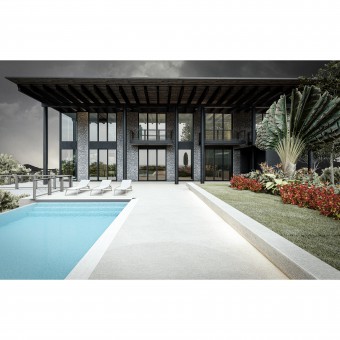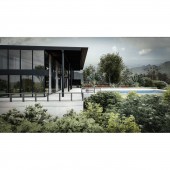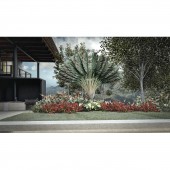La Cima Residential by Ricardo De Castro |
Home > Winners > #127859 |
 |
|
||||
| DESIGN DETAILS | |||||
| DESIGN NAME: La Cima PRIMARY FUNCTION: Residential INSPIRATION: La Cima is inspired by the unique and characteristic natural habitat of the Colombian Sierra Nevada, seeks to integrate into the environment and intervene in the terrain as little as possible. The purpose of the design is to explore the architectural relationship between the interior and the exterior, blur the boundaries between the constructed and the natural and ensure a friendly and sustainable construction with the environment. Materials of natural origin are combined with a landscaping design with characteristic species of the area. UNIQUE PROPERTIES / PROJECT DESCRIPTION: La Cima is a 340 m2 house, located in the Sierra Nevada de Santa Marta, Colombia. It was conceived as a space in total harmony with the natural environment by integrating it with the topography of the mountain. Three basic concepts are reflected in its design: sustainability, airtightness and self-sufficiency. The project is created from bioclimatic architecture premises: characteristic climate of the area and sunlight, to determine its orientation. Natural phenomena such as the greenhouse effect and the Venturi effect were used. OPERATION / FLOW / INTERACTION: The construction is oriented to the west with a direct view of the city of Santa Marta. The main access is in the southeast direction, entering the social area that integrates the kitchen, dining room and living room areas. Thanks to the glass facade, the user can see the mountains of the sierra in an eastwest direction and the city and the sea in a northwest direction. The natural slope of the land is used to the north to generate a double height area from where the user can enjoy a view of the landscape. To access the second level, a metallic helical staircase is generated that leads to the three rooms PROJECT DURATION AND LOCATION: Design Date: The design phase of the project began in January 2021 and construction began in June 2021. Location: It is located in the Sierra Nevada de Santa Marta, Colombia FITS BEST INTO CATEGORY: Architecture, Building and Structure Design |
PRODUCTION / REALIZATION TECHNOLOGY: The materials selected for the project are mostly local and low maintenance, such as the natural stone used in the facade and driveways, as well as the teak wood used in interior cladding. For the structural system, pvc and architectural concrete are selected, which are environmentally conscious materials; they comply with sustainable manufacturing processes, they are recyclable and with minimal environmental footprint indexes. To ensure the energy efficiency of the house, solar panels are placed on the roof SPECIFICATIONS / TECHNICAL PROPERTIES: La Cima is a 340m2 house, located on a 27 hectare lot at 1,475 meters above sea level. With a total height of 7.4 meters, it was conceived on two levels: the first level with a builtin area of 181 m2, housing the social areas (living room, dining room, kitchen) and service areas; and the second level with a built area of 138 m2 houses the intimate areas of rooms and bathrooms. The 360 m2 outdoor area in terraces, swimming pool, parking lots and gardens. TAGS: Cima, Sustainability, Sierra Nevada, Colombia RESEARCH ABSTRACT: The design team investigated the environmental and construction variables of the Sierra Nevada de Santa Marta, focusing attention on bioclimatic and sustainable strategies applicable to housing design. The passive design principles corresponding to natural ventilation and solar control were studied. This research resulted in the generation of a solar chimney through roof skylights and a photovoltaic energy panel system. CHALLENGE: The main challenge of the design was to generate a sustainable home with low environmental impact, where the environment was an envelope of the space and where in direct view of the sea and the mountains of the sierra. Facades were conceived with large glass windows. This solution is one of the determining architectural elements, because in addition to allowing a direct view of the environment, it allows the entry of controlled natural light and the regulation of the temperature of the interior spaces thanks to the greenhouse effect; thus minimizing energy consumption and ensuring the sustainable operation of the home. ADDED DATE: 2021-06-28 19:07:31 TEAM MEMBERS (1) : Ricardo De Castro IMAGE CREDITS: Ricardo De Castro |
||||
| Visit the following page to learn more: http://bit.ly/3jpzKPN | |||||
| AWARD DETAILS | |
 |
La Cima Residential by Ricardo De Castro is Winner in Architecture, Building and Structure Design Category, 2021 - 2022.· Read the interview with designer Ricardo De Castro for design La Cima here.· Press Members: Login or Register to request an exclusive interview with Ricardo De Castro. · Click here to register inorder to view the profile and other works by Ricardo De Castro. |
| SOCIAL |
| + Add to Likes / Favorites | Send to My Email | Comment | Testimonials | View Press-Release | Press Kit |
Did you like Ricardo De Castro's Architecture Design?
You will most likely enjoy other award winning architecture design as well.
Click here to view more Award Winning Architecture Design.








